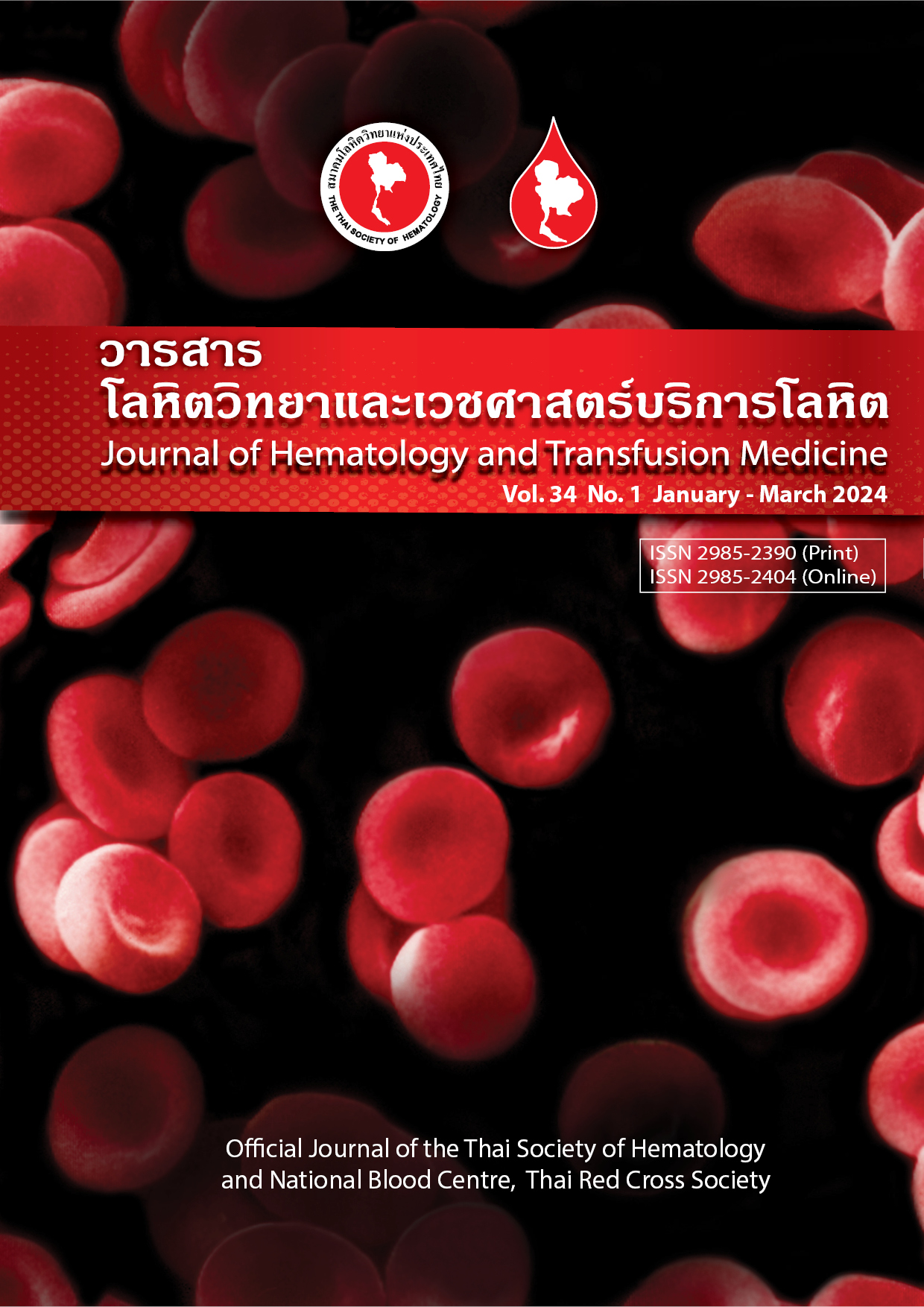ปัจจัยที่มีผลต่ออัตราการกรองนาโนในผลิตภัณฑ์ Specific immunoglobulins ของศูนย์บริการโลหิตแห่งชาติ สภากาชาดไทย
คำสำคัญ:
อิมมูโนกลอบุลิน, การกรองนาโน, อัตราการกรองบทคัดย่อ
บทคัดย่อ
บทนำ การกรองนาโน (nanofiltration) เป็นหนึ่งในเทคนิคสำคัญในการกำจัดไวรัสเพื่อเพิ่มความปลอดภัยในผลิตภัณฑ์จากพลาสมา (plasma derived medicinal products; PDMPs) ฝ่ายผลิตผลิตภัณฑ์โลหิต ศูนย์บริการโลหิตแห่งชาติ สภากาชาดไทย ได้ทำการศึกษาวิจัยในเรื่องการกรองไวรัสเพื่อลดความเสี่ยงในการปนเปื้อนของไวรัสในผลิตภัณฑ์จากพลาสมา คือ อิมมูโนโกลบูลินป้องกันโรคพิษสุนัขบ้า (human rabies immunoglobulin; HRIG) ซึ่งมีหลายปัจจัยที่มีผลต่ออัตราการกรอง วัตถุประสงค์ เพื่อศึกษาปัจจัยที่มีผลต่อความสม่ำเสมอของอัตราการกรองด้วยตัวกรองนาโน (nanofilter) ในผลิตภัณฑ์ specific immunoglobulin ของศูนย์บริการโลหิตแห่งชาติ วัสดุและวิธีการ ใช้พลาสมาที่มาจากการรับบริจาคเฉพาะส่วนจากผู้บริจาคที่มีภูมิคุ้มกันสูงต่อโรคพิษสุนัขบ้า (apheresis HRIG) เฉพาะที่ศูนย์บริการโลหิตแห่งชาติ แล้วนำไปผ่านกระบวนการตกตะกอนโปรตีนจนได้เป็นตะกอนขั้น IIC (precipitate IIC; PIIC) นำตะกอน PIIC HRIG ไปละลายน้ำ และนำไปกรองผ่านตัวกรองนาโนขนาด 20 นาโนเมตรโดยใช้ปริมาณครั้งละ 1,500 มิลลิลิตร ทำการศึกษาตั้งแต่เดือนเมษายน พ.ศ. 2562 ถึงเดือนเมษายน พ.ศ. 2563 จำนวนทั้งสิ้น 8 ครั้ง (4 รุ่นการผลิต) โดยแบ่งการศึกษาเป็น 2 ช่วง ช่วงที่ (1) การปรับเปลี่ยนความเข้มข้นของสารที่ใช้ในการปรับค่าความเป็น กรด-ด่าง ควบคู่กับ การควบคุมอุณหภูมิของสารละลายเริ่มต้นก่อนกรอง ช่วงที่ (2) การปรับปรุงวิธีการในการล้างตัวกรอง (filter-wetting process) ด้วยวิธี pressure hold เพื่อไล่ฟองอากาศที่ตกค้างในตัวกรองออกให้หมด โดยทำการทดลองใน 3 รุ่นการผลิต (3 consecutive batches) รวม 6 ครั้ง ผลการศึกษา ผลการศึกษาในช่วงที่ (1) พบว่าอัตราการกรองได้เท่ากับ 4.83 และ 2.11 kg/m2/10 hr ซึ่งค่าที่ได้ไม่เป็นที่พึงพอใจ ผลการศึกษาในช่วงที่ (2) พบว่า อัตราการกรองเป็น 4.79, 4.70, 4.44, 4.15, 6.22 และ 7.16 kg/m2/10 hr ซึ่งพบว่าผลที่ได้เป็นที่พึงพอใจ สรุป ปัจจัยที่มีผลต่ออัตราการกรองนาโน ได้แก่ การเพิ่มความเข้มข้นสารเคมีที่ใช้ในการปรับค่าความเป็นกรด-ด่าง การควบคุมอุณหภูมิของสารละลาย และเทคนิคการล้างตัวกรองให้เปียกด้วยการทำ pressure hold การใช้ทุกสภาวะร่วมกันมีผลช่วยให้อัตราการกรองดีขึ้น
Abstract:
Introduction: Nanofiltration is one of the most important viral removal techniques to increase product safety in plasma-derived medicinal products (PDMPs). This filtration step in the production process of human rabies immunoglobulin (HRIG) was studied by Blood Product Production Department of National Blood Centre (NBC), Thai Red Cross Society. To optimize the filtration rate, there are many parameters that affect the filtration rate. Objective: This study aimed to study the parameters that affected the nanofiltration process of NBC’s specific immunoglobulins. Materials and Methods: Apheresis plasma for HRIG received from rabies-immunized donors was fractionated into precipitate IIC (PIIC). Dissolved PIIC with 1,500 mL water for injection (WFI) and filtrated were filtered through 20 nm nanofilter. Four batches (eight nanofiltration processes) were conducted from April 2019 to April 2020. The studies were separated into 2 periods. The first period was increasing pH-adjust reagent concentrations combined with temperature control of the solution. Then the filter-wetting process was added in the second period by pressure holding to eliminate the bubbles that were clogged within the filter pore. Three consecutive batches (six nanofiltration processes) were operated. Results: In the first period, the results were unsatisfactory where the filtration rates were 4.83 and 2.11 kg/m2/10 hr. The results of the second period were more satisfactory where the filtration rates were 4.79, 4.70, 4.44, 4.15, 6.22 and 7.16 kg/m2/10 hr, respectively. Conclusion: There were three parameters that influenced the nanofiltration rate, increased concentration of pH-adjusted reagents, controlled solution temperature, and the filter-wetting process by pressure holding. Combining all three conditions together helped the nanofiltration rate to be satisfactory
Downloads
เอกสารอ้างอิง
Burnouf T, Radosevich M. Nanofiltration of plasma-derived biopharmaceutical products. Haemophilia. 2003;9:24-37.
World Health Organization. Guidelines on viral inactivation and removal procedures intended to assure the viral safety of human blood plasma products. Geneva: World Health Organization; 2004.
Burnouf T, Radosevich M, Goubran H, Wilkommen H. Place of nanofiltration for assuring viral safety of biologicals. Curr Nanosci. 2005;1:189-201.
Burnouf T. Modern plasma fractionation. Transfus Med Rev. 2007;21:101-17.
Roth NJ, Dichtelmüller HO, Fabbrizzi F, Flechsig E, Gröner A, Gustafson M, et al. Nanofiltration as a robust method contribution to viral safety of plasma-derived therapeutics: 20 years’ experience of the plasma protein manufacturers. Transfusion. 2020;60:2661-74.
Burnouf T. An overview of plasma fractionation. Ann Blood. 2018;3:33.
Chantanakajornfung A. Methods of plasma fractionation. J Hematol Transfus Med. 2009;19:193-202.
Chonsilapawit T, Nakdaeng T, Moriguchi M, Rungpradubvong W. The study of filter selection and finding appropriate nanofiltration condition to increase National Blood Centre’s immunoglobulin safety. J Hematol Transfus Med. 2018;28:347. (abstract).
Cohn EJ. Preparation and properties of serum and plasma proteins; a system for the separation into fractions of the protein and lipoprotein components of biological tissues and fluids. J Am Chem Soc. 1946;68:459-75.
Barukčić I, Božanić R, Kulozik U. Effect of pore size and process temperature on flux, microbial reduction and fouling mechanisms during sweet whey cross-flow microfiltration by ceramic membranes. Int Dairy J. 2014;39:8-15.
Caenn R, Darley HCH, Gray GR. The filtration properties of drilling fluids. In: Caenn R, Darley HCH, Gray GR, editors. Composition and properties of drilling and completion fluids. Texas: Gulf Professional; 2011. p.271-306.
Trotter AM, Meltzer TH. The pressure hold/drop integrity test; its correlation to diffusive flow. PDA J Pharm Sci Technol. 1998;52:182-5.
Caballero S, Nieto S, Gajardo R, Jorquera JI. Viral safety characteristics of Flebogamma® DIF, a new pasteurized, solvent-detergent treated and Planova 20 nm nanofiltered intravenous immunoglobulin. Biologicals. 2010;38:486-93.
Soluk L, Price H, Sinclair C, Atalla-Mikhail D, Genereux M. Pathogen safety of intravenous Rh immunoglobulin liquid and other immune globulin products: enhanced nanofiltration and manufacturing process overview. Am J Ther. 2008;15:435-43.
Pharmaceutical Inspection Convention and Pharmaceutical Inspection Co-operation Scheme. Guide to good manufacturing practice for medicinal products. Geneva: PIC/S; 2015 [cited 2023 Oct 8] Available from: https://picscheme.org/users_uploads/news_news_documents/ps_inf_11_2015_pics_ gmp_revised_annex_15.pdf
ดาวน์โหลด
เผยแพร่แล้ว
ฉบับ
ประเภทบทความ
สัญญาอนุญาต
ลิขสิทธิ์ (c) 2024 วารสารโลหิตวิทยาและเวชศาสตร์บริการโลหิต

อนุญาตภายใต้เงื่อนไข Creative Commons Attribution-NonCommercial-NoDerivatives 4.0 International License.



